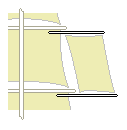User:ThoughtIdRetired/Sandbox/6


A studding sail, studsail, or stunsail[1] (traditionally pronounced stuns'l /ˈstʌnsəl/) is an extra sail set alongside square rig sails for use in light winds.
A ringtail is sometimes described as a type of studding sail, and operates in an analogous manner to a studding sail; it extends a fore and aft sail beyond its leech, so providing extra sail area in light winds.
Description[edit]

A studding sail is an extra sail set alongside a square-rigged sail on boom that extends from the Yard (sailing). It is named by appending the word studding to the name of the working sail alongside which it is set, for example, "fore topsail studdingsail".[2] These sails provide extra speed in fine weather.[3]
Studding sails were usually quadrilateral in shape, though sometimes the lower studding sails were triangular, to avoid damage if the ship rolled the lower part of the sail into the sea.
Studding sail booms were housed along the top of and slightly forward of the yards - this was to avoid interfering with work on the sail set from that yard. The inboard end of the boom could be lifted out of the way to give better access to the sail on the yard. When in use, the booms and were run out through two iron bands fastened to the yard, using a heel rope and a purchase. A studding sail boom's purpose is to take the block through which the tack[a] tensioned the lower outer corner of the sail. The booms were supported by guys (to limit fore and aft movement) and a topping lift to take the weight of the spar when being run out.
Most commonly, the outer part of the head of a studding sail is laced to a yard[b] that provided the attachment point for the outer halliard. The inner halliard simply attaches to the inner end of the head. Topsail and topgallant studding sails my be narrow enough in the head to have just a single halliard attached to a yard laced to all of the head of the sail.
Studding sails have also been used to increase the sail area of a fore-and-aft spanker, again by extending the upper spar. Such a sail extending the leech of a fore-and-aft sail is known as a ringtail.[4] Ringtail sails were used by flying 18 foot skiffs in Sydney Harbour in the 1950s to enlarge the downwind sailing capacity in light airs. Sails that extend below the boom to deck level or lower are known as watersails.
References[edit]
- ^ Lubbock, Basil (1921). The Colonial Clippers. Nautical Press, Glasgow, J. Brown & Son (Glasgow) Ltd. p. 198.
- ^ King, Dean (2000). A Sea of Words (3 ed.). Henry Holt. p. 424. ISBN 978-0-8050-6615-9.
- ^ Keegan, John (1989). The Price of Admiralty. New York: Viking. p. 281. ISBN 0-670-81416-4.
- ^ Kipping, Robert (1904). Sails & Sailmaking. Lockwood. pp. 163–164. Retrieved June 16, 2020.
Bibliography[edit]
- Harland, John (1984). Seamanship in the age of sail. Conway Maritime Press. ISBN 0-85177-179-3.
Cite error: There are <ref group=lower-alpha> tags or {{efn}} templates on this page, but the references will not show without a {{reflist|group=lower-alpha}} template or {{notelist}} template (see the help page).
